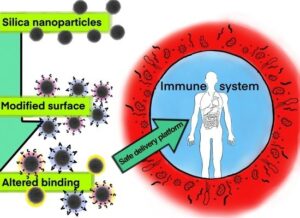Publication of the Month July
Surface Functionalization of Silica Nanoparticles: Strategies to Optimize the Immune-Activating Profile of Carrier Platforms
Benjamin Punz, Litty Johnson, Mark Geppert, Hieu-Hoa Dang, Jutta Horejs-Hoeck, Albert Duschl and Martin Himly
Abstract:
Silica nanoparticles (SiNPs) are generally regarded as safe and may represent an attractive carrier platform for nanomedical applications when loaded with biopharmaceuticals. Surface functionalization by different chemistries may help to optimize protein loading and may further impact uptake into the targeted tissues or cells, however, it may also alter the immunologic profile of the carrier system. In order to circumvent side effects, novel carrier candidates need to be tested thoroughly, early in their development stage within the pharmaceutical innovation pipeline, for their potential to activate or modify the immune response. Previous studies have identified surface functionalization by different chemistries as providing a plethora of modifications for optimizing efficacy of biopharmaceutical (nano)carrier platforms while maintaining an acceptable safety profile. In this study, we synthesized SiNPs and chemically functionalized them to obtain different surface characteristics to allow their application as a carrier system for allergen-specific immunotherapy. In the present study, crude natural allergen extracts are used in combination with alum instead of well-defined active pharmaceutical ingredients (APIs), such as recombinant allergen, loaded onto (nano)carrier systems with immunologically inert and stable properties in suspension. This study was motivated by the hypothesis that comparing different charge states could allow tailoring of the binding capacity of the particulate carrier system, and hence the optimization of biopharmaceutical uptake while maintaining an acceptable safety profile, which was investigated by determining the maturation of human antigen-presenting cells (APCs). The functionalized nanoparticles were characterized for primary and hydrodynamic size, polydispersity index, zeta potential, endotoxin contamination. As potential candidates for allergen-specific immunotherapy, the differently functionalized SiNPs were non-covalently coupled with a highly purified, endotoxin-free recombinant preparation of the major birch pollen allergen Bet v 1 that functioned for further immunological testing. Binding efficiencies of allergen to SiNPs was controlled to determine uptake of API. For efficacy and safety assessment, we employed human monocyte-derived dendritic cells as model for APCs to detect possible differences in the particles’ APC maturation potential. Functionalization of SiNP did not affect the viability of APCs, however, the amount of API physisorbed onto the nanocarrier system, which induced enhanced uptake, mainly by macropinocytosis. We found slight differences in the maturation state of APCs for the differently functionalized SiNP–API conjugates qualifying surface functionalization as an effective instrument for optimizing the immune response towards SiNPs. This study further suggests that surface-functionalized SiNPs could be a suitable, immunologically inert vehicle for the efficient delivery of biopharmaceutical products, as evidenced here for allergen-specific immunotherapy.

The open access article can be found here.
Reviewed by Angela Risch
CONGRATULATIONS!





